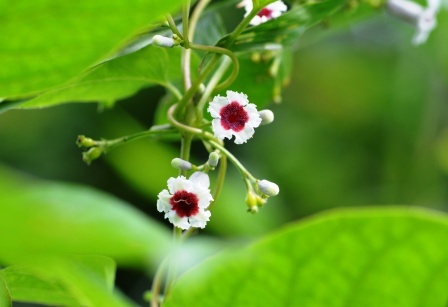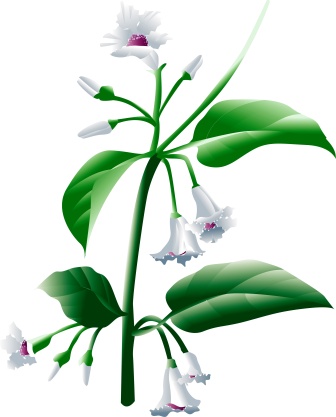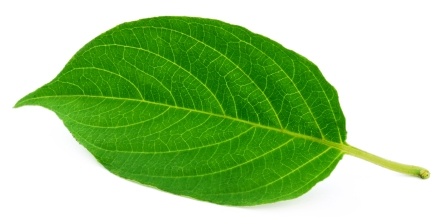Paederia foetida (Gandha Prasarini) Benefits, Usage, Dose, Side Effects
Paederia foetida (Skunk Vine) is an important Ayurvedic medicinal herb. Its Sanskrit name is Gandha Prasarini. The word’s meaning in Sanskrit is – it spreads a bad smell. It is a unique feature of this herb. Gandha means smell, prasarini means spreading.
Botanical Name- Paederia foetida Auct. Non Linn. [P.scandens(Lour) merr; Paederia tomentosa B1; Gentiana scan dens Lour]
Family – Rubiaceae (Manjishta kula)
Table of Contents
Introduction, Habitat
Skunk Vine is appreciated for its qualities like Guru guna (heaviness) and hot potency (Ushna veerya). Due to the said properties it acts effectively in pacifying the vatic complaints.
The drug is also effective in fracture healing, being aphrodisiac and in pacifying gouty arthritis.
Prasarinyadi taila, Prasarinyadi kashaya etc are the well known formulations derived out of this drug.
Habitat:
The plants are available in large quantities as a weed in Gujarat, Karnataka, Assam, Tamilnadu, Kerala and West Bengal.
The name ‘foetida’ or ‘Gandhaprasarini’ indicates the bad odor that this vine emits.
The roots are the main usable parts of this plant. But, in practice the whole plant is used for medicinal purposes.

Therapeutic uses
Vrushya – aphrodisiac
Balakrut – improves strength and immunity
Sandhanakrut – useful in wound and bone healing
Useful in Vata disorders
Almost all the massage oils used for Vata balancing contain this herb as an essential ingredient. On external use, this herb relieves pain, inflammation and stiffness.
It is useful in gout and Kapha imbalance disorders.
It is also used in treating rheumatoid arthritis.
It relieves bloating and abdominal pain.
It is usually administered after treatment of fever, to improve strength and immunity.

Home Remedies
Gandh Prasarni – Skunk vine remedies – Written by Dr MS Krishnamurthy MD(Ayu), PhD.
Abdominal pain
Leaf juice in abdominal pain and flatus:
The leaves have a foul smell. So this recipe should be administered with caution. Patients may feel nausea. To mask this, an equal quantity of lemon juice can be added to leaf juice.
Leaf is made into fine paste and squeezed to obtain the fresh juice. This is administered in the dose of 2-3 ml, preferably on an empty stomach. This relieves the abdominal pain, flatus, recurrent complaint of worm infestation etc.
Neuralgia, muscular pain
Traditional oil for Vatic complaints, especially in neuralgia and muscular pains:
Whole plant is crushed well and fine paste is made – taken in 1 part quantity
Drug decoction is prepared – taken in 16 part quantity
Sesame oil is taken in 4 parts.
The mixture is cooked till complete evaporation of the moisture.
This is used externally in the conditions of neuralgia, muscular pain, joint pains etc.
General method of preparation of decoction (kashaya) – 1 tablespoon of powder is added with 2 cups of water, boiled and reduced to 1 cup, filtered.
Arthritis
Fine paste of the whole plant in arthritis and inflammatory conditions:
The leaves are taken and fine paste is made. As per the need little tamarind leaves can also be mixed. This paste is applied over joints and it effectively pacifies the swelling and pain caused in arthritis.
Joint pain, body ache
Decoction of Gandhaprasarini , ginger and cumin seeds for joint pains and body ache:
The drugs Gandhaprasarini , Shunthi and Jeeraka are taken in equal amount and decoction is made. This is administered internally in the dose of 20-30 ml. This is effective in joint pains and body ache.
Traditional practices keep the classical knowledge alive. Even though few of the classical formulations, therapeutic uses are declining in recent days the traditional healers and folklore practitioners still use it in an un-refined way. Further, such practices stand as evidence for the future generation. That is why such folk practices and contributions of folk healers should be appreciated and due care should be given.
Click to consult Dr MS Krishnamurthy MD(Ayu), PhD
Sanskrit Synonyms
Gandhadhadhya, Balya,
Rajabala – Best herb for imparting strength
Prasarini – Use of this herb gives flexibility to the limbs
Sarani – It spreads too a long distance
Gandh Prasarni
Classical categorization
Bh. Pr Ni – Guduchyadi varga
Distribution (Utpatti sthana)
Central and Eastern Himalayan Ranges; Western Bengal to Assam.
Major chemical constituents
Asperuloside, Padedersoidic acid, paederoside, scandoside – iridous Glycosides; Valine, Tyrosine, Histidine, Carotene, Vit. Cursolic acid; Epifridelinol etc.
(Reference: Illustrated Dravyaguna Vijnana, Vol. II, by Dr JLN Shastry)
Medicinal qualities
Rasa (taste) – Tikta
Guna (qualities) – Guru, Sara
Virya (potency) – Ushna
Vipaka (taste conversion after digestion) – Katu
Effect on Tridosha – Because of its hot property, it decreases Kapha and Vata.
Pharmacological action – Antidysenteric, Anti microbial, Antitussive, Anti oxidant

Dosage, part used
Dosage–
Fresh Juice – 10-20 ml, decoction 50-100 ml
Part used– Root, leaf
Interaction with medicines, supplements
Can this be used while taking Homeopathic medicine?
Yes. This product does not react with homeopathic medicine.
Can this medicine be continued while taking supplements like multivitamin tablets, Omega 3 fatty acids etc?
Yes. Generally, this product goes well with most dietary supplements. However, if you are taking more than one product per day, please consult your doctor for an opinion.
With western
medicines
Seek your
doctor’s advice if you are taking this product along with other western
(allopathic / modern) medicines. Some Ayurvedic herbs can interact with modern
medicine.
If both Ayurvedic and allopathic medicines are advised together, then it is
best to take Allopathic medicine first, wait for 30 minutes and then take the
Ayurvedic medicine.
Ayurvedic medicines
Ayurvedic medicine with Paederia foetida-
Prasarini Thailam – used in arthritis, sciatica etc.
Maha Narayan Oil – widely used pain relieving massage oil
Marma Gulika – used in disorders of heart, kidney etc.
Vernacular Names
English Name – Stink vine and Chinese fever vine
Hindi Name– Gandhaprasarani or Pasaran
Telugu Name– Takkeda, Savirel
Bengali Name– Gandhabhaduliya, Gandhabhadule, Gandal গন্ধভাদুলে/গাঁদাল
Marathi Name– Hiran- vel
Gujarati Name – Gandhana
Tamil Name– Pinarisangai
Assamese name – Bhedai lota or Paduri lota
Morphology
Creeper
Leaves – Opposite, ovate or lanceolate
Inflorescence – Panicle
Flowers – Violet coloured, with funnel shaped corolla
Fruits -Orbicular
Sthanika Karma (Systemic Action)
External – Relieve pain, edema and stiffness. Oil is indicated in arthritis pain, joint inflammation and diseases due to Vata, kapha and Ama dosha.
Nervous System – It has vatahara action (Pacify vatadosha),. especially indicated in joint stiffness.
Digestive System – It pacifies vata dosha. indicated in Phantom tumor, abdominal cramp, constipation, abdominal distention.
Circulatory System – Being tikta in taste it purifies blood, indicated in raktagatavata (diseases due to vata and rakta origin)
Satmikarana – Promote body strength, helps for fracture healing, indicated in post viral joint pain and body stiffness
Excretory system – Increases urine output. Indicated in painful micturition and in calculi
Reproductive System – Aphrodisiac, indicated in low sperm count.










